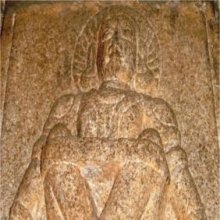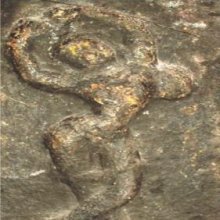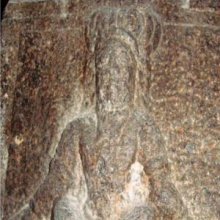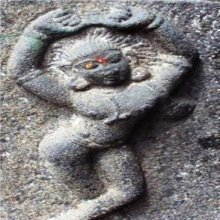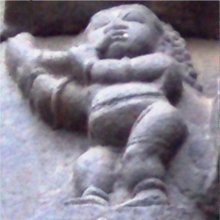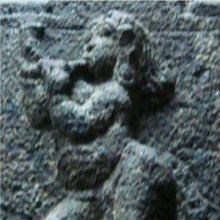Ardhamandapa, Ardhamaṇḍapa, Ardha-mandapa: 3 definitions
Introduction:
Ardhamandapa means something in Hinduism, Sanskrit. If you want to know the exact meaning, history, etymology or English translation of this term then check out the descriptions on this page. Add your comment or reference to a book if you want to contribute to this summary article.
Images (photo gallery)
(+13 more images available)
In Hinduism
Vastushastra (architecture)
Source: Wisdom Library: Vāstu-śāstraArdhamaṇḍapa (अर्धमण्डप) refers to the “half hall” of a temple.
Source: Shodhganga: Temples of Salem region Up to 1336 ADArdhamaṇḍapa (अर्धमण्डप, “half pavilion”) literally means half pavilion. It is generally found in front of the vestibule (antarāla) or in place of a vestibule. It is closed on its two sides and open on the front side. It connects the garbhagṛha (‘sanctum’) or the antarāla with the hall in front (gūḍhamanḍapa).
The ardhamaṇḍapa sometimes is provided with perforated windows (jālavātāyanas) on its two sides. The roof of the ardhamaṇḍapa is always flat, occasionally it is also paneled. Sometimes the floor level of the ardhamaṇḍapa is slightly elevated than that of the gūḍhamaṇḍapa in front.
Source: OpenEdition books: Architectural terms contained in Ajitāgama and RauravāgamaArdhamaṇḍapa (अर्धमण्डप) refers to “= mukhamaṇḍapa § 4.9.”.—(For paragraphs cf. Les enseignements architecturaux de l'Ajitāgama et du Rauravāgama by Bruno Dagens)

Vastushastra (वास्तुशास्त्र, vāstuśāstra) refers to the ancient Indian science (shastra) of architecture (vastu), dealing with topics such architecture, sculpture, town-building, fort building and various other constructions. Vastu also deals with the philosophy of the architectural relation with the cosmic universe.
General definition (in Hinduism)
Source: Google Books: Head and Heart: Valour and Self-Sacrifice in the Art of IndiaArdhamaṇḍapa (अर्धमण्डप, “half-hall”); a closed hall, anterior to the main shrine of a temple. It may be separated from the sanctuary by an antarāla or “vestibule”.
See also (Relevant definitions)
Partial matches: Ardha, Mandapa.
Full-text (+7): Antarala, Mahamandapa, Antarala-mandapa, Kiranur, Narimanam, Bhavani, Garbhagriha, Ardhanarishvara, Sittanavasal, Navaranga, Subramanya-swamy, Kurmanatha, Naganatha, Mandapa, Simhanatha, Gudhamandapa, Varahanatha, Gorakshanatha, Jalandranatha, Vyalinatha.
Relevant text
Search found 15 books and stories containing Ardhamandapa, Ardhamaṇḍapa, Ardha-mandapa, Ardha-maṇḍapa; (plurals include: Ardhamandapas, Ardhamaṇḍapas, mandapas, maṇḍapas). You can also click to the full overview containing English textual excerpts. Below are direct links for the most relevant articles:
Later Chola Temples (by S. R. Balasubrahmanyam)
Kulottunga I’s Style < [Chapter II - Temples of Kulottunga I’s Time]
Temples in Argal (Argalur) < [Chapter XII - Temples of Kulottunga III’s Time]
Temples in Tidaavur (Tadavur) < [Chapter XII - Temples of Kulottunga III’s Time]
Sripura (Archaeological Survey) (by Bikash Chandra Pradhan)
Padmapani Vihara (SRP-10) < [Chapter 2 - The Architectural Panorama]
Tivaradeva Vihara (SRP-5) < [Chapter 2 - The Architectural Panorama]
Harsadeva Vihara (SRP-4) < [Chapter 2 - The Architectural Panorama]
Early Chola Temples (by S. R. Balasubrahmanyam)
Temples in Karuntattangudi (Karandai) < [Chapter VIII - Temples of Uttama Chola’s Time]
Temples in Kuttalam < [Chapter VIII - Temples of Uttama Chola’s Time]
Temples in Nangavaram < [Chapter II - Temples of Parantaka I’s Time]
Middle Chola Temples (by S. R. Balasubrahmanyam)
Temples in Seramadevi < [Chapter II - Temples of Rajaraja I’s Time]
The Ardhamandapa and the Side Gateways < [Tanjavur/Thanjavur (Rajarajesvaram temple)]
Temples in Tirunelveli < [Chapter II - Temples of Rajaraja I’s Time]
Pallava period (Social and Cultural History) (by S. Krishnamurthy)
House, Palace and Fort (of the Pallavas) < [Chapter 4 - Material Culture of the People]
Waist-band (Kati-sutra) < [Chapter 4 - Material Culture of the People]
Polygamy < [Chapter 3 - Socio-Religious Life]
Temples in and around Madurantakam (by B. Mekala)
Appendix 3: Thiru Aatcheeswarar Temple Layout
Sri Venkateswarar Temple < [Chapter 4 - Prominent Temples in Madurantakam Taluk]
Kodandarama or Kothandarama Perumal Temple—Madurantakam < [Chapter 4 - Prominent Temples in Madurantakam Taluk]
Related products
